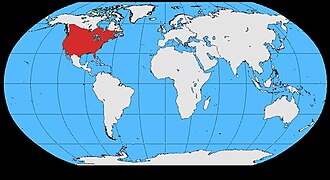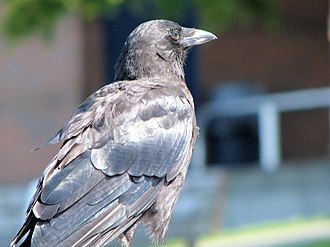Difference between revisions of "Field Guide/Birds/Corvus brachyrhynchos"
(added sound link) |
|||
| (3 intermediate revisions by the same user not shown) | |||
| Line 11: | Line 11: | ||
<tr><td>{{Ordo}}:</td><td>[[Passeriformes]]</td></tr> | <tr><td>{{Ordo}}:</td><td>[[Passeriformes]]</td></tr> | ||
<tr><td>{{Familia}}:</td><td>[[Corvidae]]</td></tr> | <tr><td>{{Familia}}:</td><td>[[Corvidae]]</td></tr> | ||
| − | <tr><td>{{Genus}}:</td><td>''[[Corvus (biology)|Corvus]]''</td></tr> | + | <tr><td>{{Genus}}:</td><td>'''''[[Corvus (biology)|Corvus]]'''''</td></tr> |
| − | <tr><td>{{Species}}:</td><td>''brachyrhynchos''</td></tr> | + | <tr><td>{{Species}}:</td><td>'''''brachyrhynchos'''''</td></tr> |
</table> | </table> | ||
<tr><th align="center" bgcolor="pink">'''[[Binomial nomenclature|Binomial name]]'''</th></tr> | <tr><th align="center" bgcolor="pink">'''[[Binomial nomenclature|Binomial name]]'''</th></tr> | ||
| − | <tr><td align="center">''Corvus brachyrhynchos''<br><small>[[ | + | <tr><td align="center">''Corvus brachyrhynchos''<br><small>[[Christian Ludwig Brehm|Brehm]], [[1822]]</small></td></tr> |
</td></tr> | </td></tr> | ||
</table> | </table> | ||
| Line 22: | Line 22: | ||
[[Image:Corvus_brachyrhynchos_map.jpg|thumb|left|Distribution map]] | [[Image:Corvus_brachyrhynchos_map.jpg|thumb|left|Distribution map]] | ||
| − | Range: Occurring from [[British Columbia]] to [[Newfoundland]] in the north, and the [[Gulf of Mexico]] to [[Florida]] in the southern parts of its range and includes virtually all types of country from wilderness, farmland, parks, open woodland to towns and major cities. | + | Range: Occurring from [[British Columbia]] to [[Newfoundland]] in the north, and the [[Gulf of Mexico]] to [[Florida]] in the southern parts of its range and includes virtually all types of country from wilderness, farmland, parks, open woodland to towns and major cities. This bird is generally a permanent resident, but many birds in the northern parts of their range [[bird migration|migrate]] short distances south. Outside of the nesting season, these birds often gather in large communal roosts at night. |
| − | Food: A typical crow taking invertebrates of all types, [[carrion]], scraps of human food, seeds, eggs and nestlings, stranded fish on the shore and various grains. It also, like most crows, scavenges at rubbish dumps. | + | Food: A typical crow taking invertebrates of all types, [[carrion]], scraps of human food, seeds, eggs and nestlings, stranded fish on the shore and various grains. It also, like most crows, scavenges at rubbish dumps. Where available, [[maize|corn]] is a favorite food. |
| − | Nest: | + | Nest: These birds build bulky stick nests, nearly always in trees but sometimes also in large bushes and, very rarely, on the ground. 3 to 6 eggs are laid and [[incubate (bird)|incubate]]d for 18 days. The young are fledged usually by about 35 days. Normally single nesting, the species has been recorded as nesting in small colonies in the western parts of its range. |
| − | Voice: The most usual call is a short and rapid ''"caah-caah-caah"''. | + | Voice: The most usual call is a short and rapid ''"caah-caah-caah"''. However, they can produce a wide variety of sounds and sometimes mimic noises made by other birds and animals. |
| − | + | ==Voice sound link:== http://www.shades-of-night.com/aviary/sounds/crow2.wav | |
| + | ----- | ||
| + | Status: Despite attempts by humans in some areas to drive these birds away, they remain widespread and very common. | ||
| + | |||
| + | The [[Northwestern Crow]] ''Corvus caurinus'' is very closely related to the American Crow and indeed structurally, they almost blend into each other in northern [[Oregon]] though the voice remains one of the principal differences between these two close species. | ||
[[Image:Common_crow.jpg|thumb|left|Painting of American Crow]] | [[Image:Common_crow.jpg|thumb|left|Painting of American Crow]] | ||
| − | == | + | |
| + | ==External image links== | ||
* [http://www.mesange.com/corneille_amerique.htm American Crow series] | * [http://www.mesange.com/corneille_amerique.htm American Crow series] | ||
Revision as of 20:50, 27 December 2004
| American Crow | ||||||||||||||
|---|---|---|---|---|---|---|---|---|---|---|---|---|---|---|
| 200px | ||||||||||||||
| Template:Taxonomy | ||||||||||||||
| ||||||||||||||
| Binomial name | ||||||||||||||
| Corvus brachyrhynchos Brehm, 1822 |
The American Crow (Corvus brachyrhynchos) is slightly smaller than the European Carrion Crow in overall size (39-49 cm in length) and also has a proportionately smaller bill. Feathers are black, with a purple or blue iridescence in some lights. Legs, feet and bill are also black. Several regional forms are recognized and differ in bill proportion and overall size from each other across North America, generally smallest in the southeast and the far west.
Range: Occurring from British Columbia to Newfoundland in the north, and the Gulf of Mexico to Florida in the southern parts of its range and includes virtually all types of country from wilderness, farmland, parks, open woodland to towns and major cities. This bird is generally a permanent resident, but many birds in the northern parts of their range migrate short distances south. Outside of the nesting season, these birds often gather in large communal roosts at night.
Food: A typical crow taking invertebrates of all types, carrion, scraps of human food, seeds, eggs and nestlings, stranded fish on the shore and various grains. It also, like most crows, scavenges at rubbish dumps. Where available, corn is a favorite food.
Nest: These birds build bulky stick nests, nearly always in trees but sometimes also in large bushes and, very rarely, on the ground. 3 to 6 eggs are laid and incubated for 18 days. The young are fledged usually by about 35 days. Normally single nesting, the species has been recorded as nesting in small colonies in the western parts of its range.
Voice: The most usual call is a short and rapid "caah-caah-caah". However, they can produce a wide variety of sounds and sometimes mimic noises made by other birds and animals.
==Voice sound link:== http://www.shades-of-night.com/aviary/sounds/crow2.wav
Status: Despite attempts by humans in some areas to drive these birds away, they remain widespread and very common.
The Northwestern Crow Corvus caurinus is very closely related to the American Crow and indeed structurally, they almost blend into each other in northern Oregon though the voice remains one of the principal differences between these two close species.


